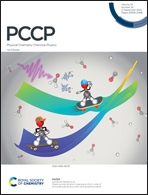Doping of the Mn vacancy of Mn2B2 with a single different transition metal atom as the dual-function electrocatalyst†
Abstract
The design of efficient electrocatalysts is essential to enhance the performance of rechargeable metal–air cells, renewable fuel cells and overall water splitting. Based on this, how to improve the catalytic activity of oxygen reduction reaction (ORR), oxygen evolution reaction (OER) and hydrogen evolution reaction (HER) becomes self-evident. Currently, single atom catalysts (SACs) are widely used as structural design models for the OER, ORR and HER because of the single active site and maximum metal atom utilization, but significant challenges remain. Herein, the catalytic properties of the OER, ORR and HER with a single metal atom as the active site are discussed through first-principles calculations by introducing a single metal atom in the Mn vacancy of Mn2B2 (TM@Mn2B2, TM = Au, Ag, Co, Cd, Cu, Ir, Pd, Ni, Rh, Ru and Pt). The results show that Ni@Mn2B2 is suitable as a dual-function electrocatalyst for the OER/ORR with overpotentials of 0.38 V and 0.37 V, which are lower than those of the OER overpotential of RuO2/IrO2 (0.42 V/0.56 V) and the ORR overpotential of Pt (0.45 V). Meanwhile, Pt@Mn2B2 is available as an OER/HER dual-function electrocatalyst for overall water splitting with a lower overpotential of OER (0.45 V) and lower |ΔGH| (-0.15eV) under 1/4 hydrogen coverage for the HER. This work proposes a practical strategy for developing single metal atom doped MBene as a dual-function electrocatalyst.



 Please wait while we load your content...
Please wait while we load your content...